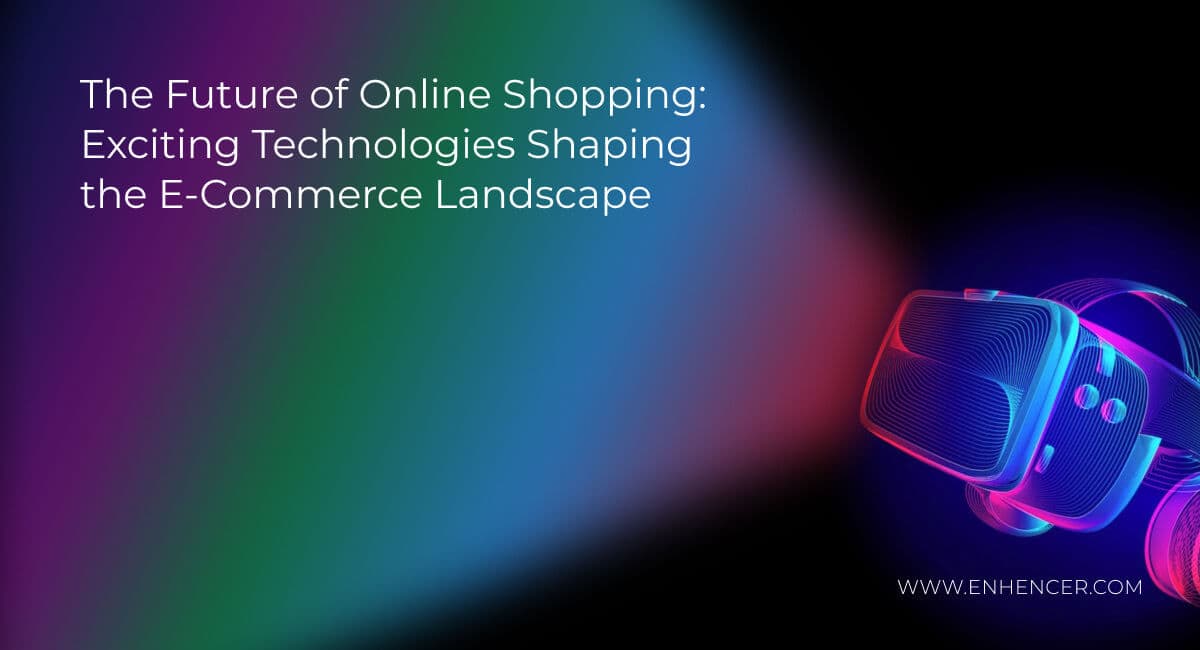Introduction
In recent years, technological innovations have surged forward, creating a convergence of possibilities that promise to reshape the
e-commerce landscape in ways we could only dream of.
The conveniences of today's online shopping experience have become so deeply ingrained in our lives that we can hardly imagine a
time when we couldn't browse, compare, and purchase products with just a few clicks. But now, as we venture deeper into the digital
realm, we are on the brink of a new era—one marked by cutting-edge technologies that are set to revolutionize how we shop, connect,
and experience the world of commerce.
In today's blog, we delve deeper into the transformative potential of these cutting-edge technologies and their impact on the
future of e-commerce. Each of these innovations brings unique advantages to the table, and businesses that leverage them
effectively can gain a competitive edge in the dynamic world of online shopping.
Let's start by exploring the immense potential of Augmented Reality (AR) for virtual try-ons. This technology has already begun
reshaping how customers interact with products online. Gone are the days of uncertainty and hesitation when purchasing clothing,
accessories, or furniture online. With AR, customers can virtually "try on" products, visualizing how they would look and fit in
the real world. This level of immersion and personalization significantly reduces the likelihood of returns, which has long been a
challenge for the e-commerce industry. Retailers that embrace AR can expect increased customer satisfaction, improved conversion
rates, and a stronger emotional connection with their audience.
Augmented Reality (AR) for Virtual Try-Ons
Augmented reality has emerged as a game-changer in the e-commerce industry, revolutionizing how customers interact with products
online. With AR-enabled virtual try-ons, shoppers can digitally "try on" products like clothing, accessories, and furniture before
purchasing. This technology eliminates the uncertainty of buying online, reducing the likelihood of returns and boosting customer
satisfaction.
Imagine trying on a pair of sunglasses or a new outfit from the comfort of your home, with lifelike digital representations
superimposed on your real-world surroundings. AR enhances the shopping experience and opens new possibilities for customization,
allowing customers to tailor products to their preferences.
Retailers who integrate AR into their e-commerce platforms can differentiate themselves in a competitive market, build stronger
customer loyalty, and tap into the vast potential of immersive shopping experiences.
Next, we have Voice Commerce, which is fast becoming a game-changer in the e-commerce landscape. As natural language processing and
voice recognition technologies advance, the ease and convenience of conversational shopping are transforming how customers interact
with online stores. Voice assistants and smart speakers have become trusted shopping companions, allowing customers to add items to
their carts and place orders through voice commands. This hands-free shopping experience streamlines the purchasing process and
offers unparalleled accessibility for customers with disabilities or busy lifestyles. Businesses integrating voice commerce into
their platforms can enhance customer service and gain valuable consumer behavior and preferences insights.
Voice Commerce: The Power of Conversational Shopping
Voice commerce is rapidly gaining popularity, thanks to the proliferation of smart speakers and virtual assistants. As natural
language processing and voice recognition technologies advance, customers can purchase by simply speaking their commands. This
hands-free shopping experience offers unparalleled convenience and accessibility for customers, transforming the way they interact
with e-commerce platforms.
By leveraging voice commerce, businesses can enhance customer service, streamline shopping, and gain valuable insights into
consumer behaviour. As voice commerce grows, integrating this technology into e-commerce platforms will become crucial for staying
relevant and competitive.
Blockchain for Supply Chain Transparency
Transparency and trust are vital components of successful e-commerce operations. Blockchain, the decentralized and immutable ledger
technology, holds the potential to revolutionize supply chain management in the industry. Using blockchain, businesses can create a
tamper-proof record of every transaction, ensuring transparency and traceability throughout the supply chain.
From product sourcing and manufacturing to shipping and delivery, blockchain can verify the authenticity and origin of goods,
helping to eliminate counterfeit products and ensure ethical sourcing practices. This increased transparency builds consumer trust
and aids in compliance with regulations and standards.
AI-Driven Personalization: The Path to Tailored Shopping Experiences
Artificial Intelligence (AI) has already transformed several aspects of the e-commerce industry, and one of its most significant
impacts is personalization. AI-driven algorithms analyze vast amounts of customer data to understand individual preferences,
shopping habits, and behavior, allowing businesses to deliver highly targeted and personalized shopping experiences.
From product recommendations to dynamic pricing, AI can tailor every step of the customer journey, increasing customer satisfaction
and higher conversion rates. Moreover, AI chatbots and virtual assistants provide real-time assistance, enhancing customer support
and reducing response times.
As AI technology evolves, businesses must embrace its capabilities to stay ahead of the competition and provide customers with
hyper-personalized shopping experiences.
Wrapping Up
The future of online shopping holds immense potential, fueled by the adoption of cutting-edge technologies. Augmented reality,
voice commerce, blockchain, and AI-driven personalization are set to revolutionize the e-commerce landscape, reshaping how
customers shop, and businesses operate.
For retailers, staying ahead in this ever-evolving industry means embracing these emerging trends and integrating them seamlessly
into their e-commerce platforms. By doing so, businesses can enhance the customer experience, build trust, and unlock new
opportunities for growth and success in the future of e-commerce. As customers demand more immersive and personalized shopping
experiences, businesses need to adapt and embrace these exciting technologies to thrive in the dynamic world of online shopping.














